
Resident Evil 4 is a survival horror game by Capcom, originally released for the GameCube in 2005. Players control the special agent Leon S. Kennedy on a mission to rescue the US president's daughter, Ashley Graham, who has been kidnapped by a religious cult in rural Spain. Leon fights hordes of enemies infected by a mind-controlling parasite and reunites with the spy Ada Wong. In a departure from the fixed camera angles and slower gameplay of previous Resident Evil games, Resident Evil 4 features a dynamic camera system and action-oriented gameplay.

The Capcom Five are five video games that were unveiled by Capcom in late 2002 and published from March 2003. At a time when Nintendo's GameCube console had failed to capture market share, Capcom announced five new GameCube titles with the apparent goal of boosting hardware sales and demonstrating third-party developer support. Capcom USA followed up with confirmation that they would be exclusive to the GameCube. The five games were P.N.03, a futuristic third-person shooter; Viewtiful Joe, a side-scrolling action-platformer; Dead Phoenix, a shoot 'em up; Resident Evil 4, a survival horror third-person shooter; and Killer7, an action-adventure game with first-person shooter elements. Though not directly related to each other, they were all overseen by Resident Evil director Shinji Mikami and, except Killer7, developed by Capcom's Production Studio 4. Capcom USA later clarified that only Resident Evil 4 was intended to be exclusive; the initial announcement was due to a miscommunication with their parent company.
MT Framework is a game engine created by Capcom. "MT" stands for "Multi-Thread", "Meta Tools" and "Multi-Target". While initially MT Framework was intended to power 2006's Dead Rising and Lost Planet: Extreme Condition only, Capcom later decided for their internal development divisions to adopt it as their default engine. As a result, the vast majority of their internally developed video games for the PlayStation 3 and Xbox 360 platforms were created on it, including four new titles and three remastered ports of past titles in the Resident Evil series. The visuals of the first games built with the engine were well received, and MT Framework has also won a CEDEC award.

Resident Evil: Degeneration, known as Biohazard: Degeneration in Japan, is a 2008 Japanese adult animated biopunk action horror film directed by Makoto Kamiya. It is the first full-length motion capture animation feature in Capcom's Resident Evil franchise. The film was made by Capcom in cooperation with Sony Pictures Entertainment Japan. Degeneration made its premiere at the 2008 Tokyo Game Show and was released theatrically on October 17, 2008.

Resident Evil 6 is a 2012 third-person shooter video game developed and published by Capcom. A major installment in the Resident Evil series, Resident Evil 6 was released for the PlayStation 3 and Xbox 360 in October 2012, and for Windows in March 2013. It was re-released with all downloadable content for the PlayStation 4 and Xbox One in March 2016, and for the Nintendo Switch in October 2019. Players control Leon S. Kennedy, Chris Redfield, Jake Muller and Ada Wong as they confront the force behind a worldwide bio-terrorist attack. The story is centred around their four interwoven campaigns, and every campaign features a unique style in both tone and gameplay.
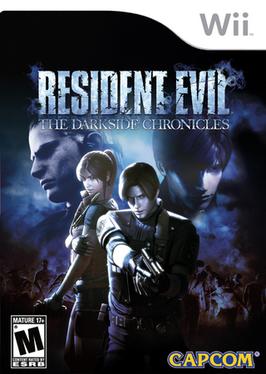
Resident Evil: The Darkside Chronicles is an on-rails light gun shooter video game for the Wii developed by Capcom and Cavia as part of the Resident Evil series. The game was released for the Wii on November 17, 2009, in North America. It serves as a prequel to Resident Evil 4, set 2 years before its events. It was released in Europe on November 27, 2009, bundled with the Wii Zapper accessory.

Super Street Fighter IV is a 2.5D fighting game produced by Capcom. It is an updated version of Street Fighter IV and has been said to mark the definitive end of the Street Fighter IV series. Having been deemed too large an update to be deployed as DLC, the game was made into a standalone title but given a lower price than that of a full retail game. It was released in April 2010 for the PlayStation 3 and Xbox 360. Super Street Fighter IV: 3D Edition was released as one of the launch titles for the Nintendo 3DS, with 3D functionality, on February 26, 2011, in Japan. The game has sold 1.9 million units worldwide, while the 3D Edition for the 3DS has sold an additional 1.1 million units worldwide.

Professor Layton and the Miracle Mask is a puzzle adventure video game developed by Level-5. It is the fifth game in the Professor Layton series, the second in the prequel trilogy of games, and the first in the series to be developed for the Nintendo 3DS. Miracle Mask was released as a launch title for the Nintendo 3DS in Japan in February 2011, becoming the best-selling game on the day of the system's launch. The game was later released worldwide in October 2012. Professor Layton and the Miracle Mask Plus, an enhanced edition featuring new puzzles and added cutscenes, was released on the Nintendo eShop in Japan in February 2013.
Claire Redfield is a character in Resident Evil, a survival horror video game series created by the Japanese company Capcom. She was first introduced as one of two player characters in Resident Evil 2 (1998), alongside Leon S. Kennedy.

Monster Hunter Portable 3rd is the third handheld installment in the Monster Hunter franchise, developed by Capcom for the PlayStation Portable. Like its predecessor, Monster Hunter Freedom 2, Portable 3rd is an original title that adapts the core content of Monster Hunter Tri into a new single player campaign, adding supplemental original content. The game introduces regions, monsters, and a revised Felyne combat system.

Resident Evil: Revelations is a 2012 survival horror video game developed and published by Capcom originally for the Nintendo 3DS handheld game console. Set shortly after the events of Resident Evil 4, the game follows counter-terrorism agents Jill Valentine and Chris Redfield as they try to uncover the truth behind a bioterrorist organization that plans to infect the Earth's oceans with a virus. The game features a single-player mode where the player must complete a series of episodes that involve solving puzzles and defeating enemies, and a multiplayer mode where players may fight their way through altered single-player scenarios.
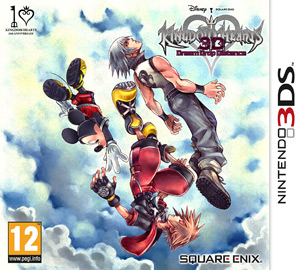
Kingdom Hearts 3D: Dream Drop Distance is an action role-playing video game developed and published by Square Enix for the Nintendo 3DS, revealed at E3 2010. The game is the seventh installment in the Kingdom Hearts series and was released in Japan on March 29, 2012. It was released in Europe on July 20, 2012, in Australasia on July 26, 2012, and in North America on July 31, 2012.

Super Street Fighter IV: 3D Edition is a fighting video game developed and published by Capcom for the Nintendo 3DS handheld game console. It was released as a launch game in all continents, but in Japan first on 26 February 2011. It is a port of the console game Super Street Fighter IV. The game has sold 1.3 million units worldwide for 3DS.
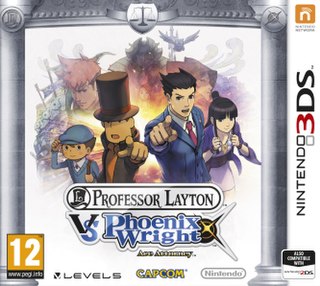
Professor Layton vs. Phoenix Wright: Ace Attorney is a visual novel adventure puzzle video game for the Nintendo 3DS, and was developed by both Capcom and Level-5, the latter publishing it in Japan while Nintendo published it worldwide. The game is a crossover between two game series from both developers, combining the puzzle and exploration elements of Level-5's Professor Layton series, and the general trial mechanics of Capcom's Ace Attorney adventure series, the latter enhanced by the addition of a few new elements, including multiple witnesses and jury trials, a concept continued with into the prequel series The Great Ace Attorney. Shu Takumi, the series director for the Ace Attorney series, assisted with the scenario designs for the game. The plot focuses on Professor Layton and Phoenix Wright, along with their respective assistants, working together to solve the mystery behind a young girl that they both encounter separately, and a strange world they are brought to through her, with Layton focused on solving puzzles and finding clues to solve the mystery, while Wright focuses on defending people who are put on trial for being "witches".
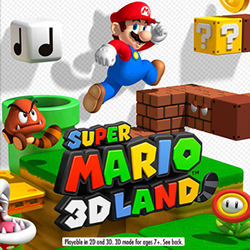
Super Mario 3D Land is a 2011 platform game in the Super Mario series developed and published by Nintendo for their Nintendo 3DS handheld game console. It was released worldwide in November 2011, beginning in Japan. It was the first Mario game to be released for the 3DS.
The Guild series is a compilation of video games produced by Level-5 for the Nintendo 3DS in cooperation with various game designers. The first compilation, Guild01, consists of four games and was released at retail in Japan on May 31, 2012. Three of the titles have been announced for individual release on the Nintendo eShop in Western territories during Fall 2012. All four of them were released individually on the Japanese eShop not long after. A second compilation, Guild02, which features three games designed by Keiji Inafune, Kazuya Asano, Takemaru Abiko and Kaz Ayabe, was released on the Nintendo eShop in Japan during March 2013 and began releasing in Western territories in May 2013.
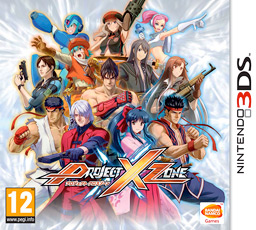
Project X Zone is a crossover tactical role-playing video game for the Nintendo 3DS developed by Monolith Soft with assistance from Capcom and Red Entertainment and published by Namco Bandai Games. It is a follow-up to Namco × Capcom and features characters from Namco Bandai, Capcom, and Sega. The game was released on October 11, 2012 in Japan; June 25, 2013 in North America; and July 5, 2013 in Europe. Project X Zone received mixed to positive reviews upon release; praise went towards the game's cast, combat system, and presentation, but criticism was directed at its repetitive gameplay and confusing storyline.

E.X. Troopers, stylized as E.X. Tr∞pers, is a third-person shooter video game developed and published by Capcom for Nintendo 3DS and PlayStation 3. The game was released in Japan to retail customers on November 22, 2012 and later on Nintendo eShop and PlayStation Network on January 24, 2013.

Resident Evil: Revelations 2 is an episodic survival horror video game developed and published by Capcom as part of the Resident Evil series. The game is a follow-up to Resident Evil: Revelations and Resident Evil 5. It marks the return of Claire Redfield as the protagonist, and the first time Barry Burton is a playable story character in the main series. It is also the first Resident Evil game to not feature Alyson Court as the long time voice of Claire Redfield. The first installment was released in February 2015.
















